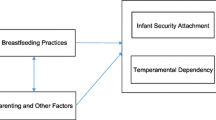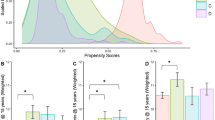Abstract
In a longitudinal study of 100 low-income, mother-infant dyads, assessments of infant attachment security and maternal responsivity, involvement, depressive symptomatology, and perceived infant difficulty were used to predict later behavior problems at age 3. Attachment insecurity was related to behavior problems at age 3 when all insecure classifications were combined into one group and when insecurity was maintained at 12 and 18 months. For boys only, maternal depressive symptoms and low maternal involvement were associated with age 3 behavior problems. For girls, perceived difficult temperament at ages 1 and 2 were associated with later problem behavior.
Similar content being viewed by others
References
Achenbach, T. M. (1992).Manual for the Child Behavior Checklist/2–3 and 1992 Profile. Burlington: University of Vermont, Department of Psychiatry.
Achenbach, T. M., McConaughy, S. H., & Howell, C. T. (1987). Child/adolescent behavioral and emotional problems: Implications of cross-informant correlations for situational specificity.Psychological Bulletin, 101, 213–232.
Ainsworth, M. D. S., Blehar, M. C., Waters, E., & Wall, S. (1978).Patterns of attachment. Hillsdale, NJ: Erlbaum.
Ainsworth, M. D. S., & Wittig, D. (1969). Attachment and exploratory behavior of one-year-olds in a strange situation. In B. M. Foss (Ed.),Determinants of infant behavior (Vol. 4). London: Metheun.
Arend, R., Gove, F. L., & Sroufe, L. A. (1979). Continuity of individual adaptation from infancy to kindergarten: A predictive study of ego-resiliency and curiosity in preschoolers.Child Development, 50, 950–959.
Bates, J. E., Freeland, C. B., & Lounsbury, M. L. (1979). Measurement of infant difficultness.Child Development, 50, 794–803.
Bates, J. E., Maslin, C. A., & Frankel, K. A. (1985). Attachment security, mother-child interaction, and temperament as predictors of behavior-problem ratings at age three years. In I. Bretherton & E. Waters (Eds.),Monographs of the Society for Research in Child Development, 50 (1–2), 167–193.
Beck, A. T., & Beamesderfer, A. (1974). Assessment of depression: The Depression Inventory. In P. Pichot (Ed.),Psychological measurement in psychopharmacology: Modern problems in pharmacopsychiatry (Vol. 7). Basel, Switzerland: Kanger.
Caldwell, B. M., & Bradley, R. H. (1984).Manual for the Home Observation of the Environment (rev. ed.). Unpublished manuscript, University of Arkansas, Little Rock.
Campbell, S. B., Breaux, A. M., Ewing, L. J., & Szumowski, E. K. (1986). Correlates and predictors of hyperactivity and aggression: A longitudinal study of parent-referred problem preschoolers.Journal of Abnormal Child Psychology, 14, 217–234.
Christopoulos, C., Cohn, D. A., Shaw, D. S., Joyce, S., Sullivan-Hanson, J., Kraft, S. P., & Emery, R. E. (1987). Children of abused women: I. Adjustment at time of shelter residence.Journal of Marriage and the Family, 49, 611–619.
Downey, G., & Coyne, J. C. (1990). Children of depressed parents: An integrative review.Psychological Bulletin, 108, 50–76.
Downey, G., Feldman, S., Khuri, J., & Friedman, S. (in press). Maltreatment and childhood depression. In W. M. Reynolds & H. F. Johnson (Eds.),Handbook of depression in children. New York: Plenum Press.
Egeland, B., & Farber, E. A. (1984). Infant-mother attachment: Factors related to its development and changes over time.Child Development, 55, 753–771.
Erickson, M. F., Sroufe, L. A., & Egeland, B. (1985). The relationship between quality of attachment and behavior problems in preschool in a high-risk sample. In I. Bretherton & E. Waters (Eds.), Growing points of attachment theory and research.Monographs of the Society for Research in Child Development, 50 (1–2), 147–167.
Fagot, B. (1984). The consequents of problem behaviors in toddler children.Journal of Abnormal Child Psychology, 12, 385–395.
Fagot, B. I., & Kavanagh, K. (1990). The prediction of antisocial behavior from avoidant attachment classifications.Child Development, 62, 864–873.
Fagot, B. I., & Kavanagh, K. (1993). Parenting during the second year: Effects of children's age, sex, and attachment classification.Child Development, 64, 258–271.
Fergusson, D. M., Lynskey, M. T., & Horwood, L. J. (1993). The effect of maternal depression on maternal ratings of child behavior.Journal of Abnormal Child Psychology, 21, 345–270.
Forehand, R., McCombs, A., & Brody, G. H. (1987). The relationship of parental depressive mood states to child functioning: An analysis by type of sample and area of child functioning.Advances in Behavioral Research and Therapy, 9, 1–20.
Glueck, S., & Glueck, E. (1950).Unraveling juvenile delinquency. New York: Commonwealth Fund.
Goodman, S. H., & Brumley, H. E. (1990). Schizophrenic and depressed mothers: Relational deficits in parenting.Developmental Psychology, 26, 31–39.
Greenberg, M. T., & Speltz, M. L. (1988). Contributions of attachment theory to the understanding of conduct problems during the preschool years. In J. Belsky & T. Negworski (Eds.),Clinical implications of attachment (pp. 177–218). Hillsdale: Erlbaum.
Greenberg, M. T., Speltz, M. L., & DeKlyen, M. (1993). The role of attachment in the early development of disruptive behavior problems.Development and Psychopathology, 5, 191–213.
Hirschi, T. (1969).Causes of delinquency. Berkeley: University of California.
Jacobson, J. L., & Willie, D. E. (1986). The influence of attachment pattern of developmental changes in peer interaction from the toddler to the preschool period.Child Development, 57, 338–347.
Kazdin, A. K. (1987).Conduct disorders in childhood and adolescence. Newbury Park, CA: Sage.
Keenan, K., & Shaw, D. S. (in press). The development of coercive family processes: the interaction between aversive toddler behavior and parenting factors. In J. McCord (Ed.),Coercion and punishment in long-term perspectives. Boston: Cambridge Press.
LaFreniere, P. J., & Sroufe, L. A. (1985). Profiles of peer competence in the preschool: Interrelations among measures, influence of social ecology, and relation to attachment history.Development Psychology, 21, 56–69.
Lewis, M., Feiring, C., McGuffog, C., & Jaskir, J. (1984). Predicting psychopathology in six-year-olds from early social relations.Child Development, 55, 123–136.
Loeber, R. (1982). The stability of antisocial and delinquent childhood behavior.Child Development, 53, 1431–1446.
Loeber, R., & Dishion, T. (1983). Early predictors of male delinquency: A review.Psychological Bulletin, 94, 68–99.
Loeber, R., & Stouthamer-Loeber, M. (1986). Family factors as correlates and predictors of juvenile conduct problems and delinquency. In M. Tonry and N. Morris (Eds.),Crime and justice: A review of research (Vol. 7, pp. 29–149). Chicago: University of Chicago Press.
Londerville, S, & Main, M. (1981). Security of attachment, compliance, and maternal training methods in the second year of life.Developmental Psychology, 17, 289–299.
Lyons-Ruth, K., Alpern, L., & Repacholi, B. (1993). Disorganized infant attachment classification and maternal psychosocial problems as predictors of hostile-aggressive behavior in the preschool classroom.Child Development, 64, 572–585.
Lyons-Ruth, K, Connell, D. B., Zoll, D., & Stabl, J. (1987). Infants at social risk: Relations among infant maltreatment, maternal behavior, and infant attachment behavior.Developmental Psychology, 23, 223–232.
Lyons-Ruth, K., Repacholi, B., McLeod, S., & Silva, E. (1991). Disorganized attachment behavior in infancy: Short-term stability, maternal and infant correlates and risk-related sub-types.Development and Psychopathology, 3, 377–396.
Main, M., & Solomon, J. (1987). Discovery of an insecure disorganized/disoriented attachment pattern: Patterns, findings and implications for the classification of behavior. In M. Yogman & T. B. Brazelton (Eds.),Affective development in infancy (pp. 95–124). Norwood, NJ: Ablex.
Mangelsdorf, S., Gunnar, M., Kestenbaum, R., Lang, S., & Andreas, D. (1990). Infant proneness-to-distress, temperament, maternal personality, home behavior, and mother-infant attachment: Associations and goodness of fit.Child Development, 61, 820–831.
Martin, J. (1981). A longitudinal study of the consequences of early mother-infant interaction: A microanalytic approach.Monographs of the Society for Research in Child Development, 46 (3, Serial No. 190).
Matas, L., Arend, R. A., & Sroufe, L. A. (1978). Continuity of adaptation in the second year: The relationship between quality of attachment and later competence.Child Development, 49, 547–556.
Radke-Yarrow, M., Cummings, E. M., Kuczynski, L., & Chapman, M. (1985). Patterns of attachment in two-and three-year-olds in normal families and families with parental depression.Child Development, 56, 884–892.
Renken, B., Egeland, B., Marvinney, D., Mangeldorf, S., & Sroufe, L. A. (1989). Early childhood antecedents of aggression and passive-withdrawal in early elementary school.Journal of Personality, 57, 257–281.
Reynolds, W. M., & Gould, J. W. (1981). A psychometric investigation of the standard and short form Beck Depression Inventory.Journal of Consulting and Clinical Psychology, 49, 306–307.
Richters, J. E. (1992). Depressed mothers as informants about their children: A critical review of the evidence for distortion.Psychological Bulletin, 112, 485–499.
Rose, S. L., Rose, S. A., & Feldman, J. F. (1989). Stability of behavior problems in very young children.Development and Psychopathology, 1, 5–19.
Sanson, A., Oberklaid, F., Pedlow, R., & Prior, M. (1991). Risk indicators: Assessment of infancy predictors of pre-school behavioral maladjustment.Journal of Child Psychology and Psychiatry, 32, 609–626.
Shaw, D. S., & Bell, R. Q. (1993). Developmental theories of parental contributors to antisocial behavior.Journal of Abnormal Child Psychology, 21, 35–49.
Shaw, D. S., & Emery, R. E. (1988). Chronic family adversity and school-age children's adjustment.Journal of the American Academy of Child and Adolescent Psychiatry, 27, 200–206.
Shaw, D. S., Keenan, K., & Vondra, J. I. (1994). Developmental precursors of externalizing behavior problems: Ages 1 to 3.Developmental Psychology, 30, 355–364.
Smith, P. B., & Pederson, D. R. (1988). Maternal sensitivity and patterns of mother-infant attachment.Child Development, 59, 1097–1101.
Sroufe, L. A., Egeland, B., & Kreutzer, T. (1990). The fate of early experience following developmental change: Longitudinal approaches to individual adaptation in childhood.Child Development, 61, 1363–1373.
Sroufe, L. A., & Fleeson, J. (1986). Attachment and the construction of relationships. In W. W. Hartup and Z. Rubin (Eds.),Relationships and development (pp. 51–71). Hillsdale, NJ: Erlbaum.
Zahn-Waxler, C. (1993).Continuities of behavior problems in preschool children. Paper presented at the Society for Research in Child Development, New Orleans.
Zahn-Waxler, C., Iannotti, R. J., Cummings, E. M., & Denham, S. (1990). Antecedents of problem behavior in children of depressed mothers.Development and Psychopathology, 2, 271–291.
Author information
Authors and Affiliations
Additional information
The authors are indebted to Richard Bell for reading drafts of the manuscript, and the many graduate and undergraduate staff members who assisted in data collection. The study was supported by grants to Daniel Shaw and Joan Vondra from the following organizations within the University of Pittsburgh: the Mental Health Clinical Research Center for Affective Disorders, the Central Research Development Fund, the Office of Child Development, the School of Education in conjunction with the Buhl Foundation, and the Faculty of Arts and Sciences.
Rights and permissions
About this article
Cite this article
Shaw, D.S., Vondra, J.I. Infant attachment security and maternal predictors of early behavior problems: A longitudinal study of low-income families. J Abnorm Child Psychol 23, 335–357 (1995). https://doi.org/10.1007/BF01447561
Received:
Issue Date:
DOI: https://doi.org/10.1007/BF01447561




